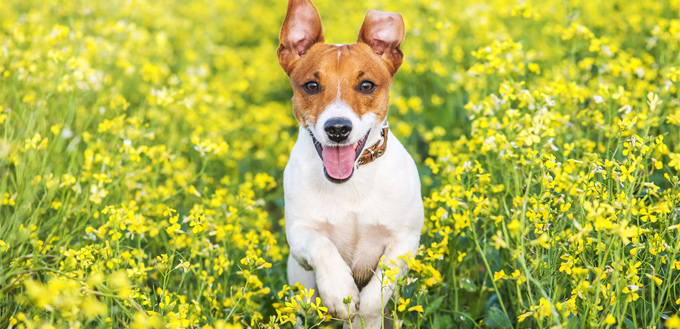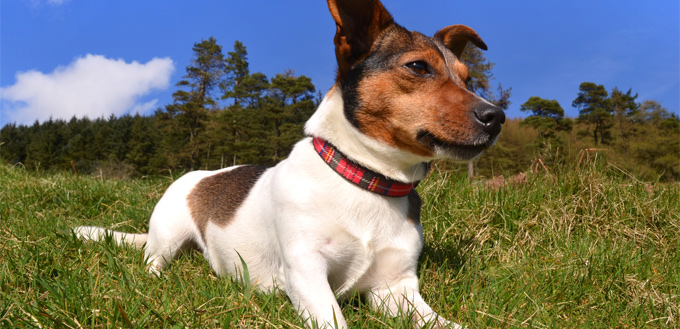Don’t let its size fool you. The Jack Russell Terrier or JRT may be small, but its level of activity and cleverness can never be contained in a small package. Brimming with life and full of vigor, the JRT is a small wonder dog that was primarily bred to hunt foxes and beavers from their burrows and hiding places. And as man no longer hunts for these prey animals, the JRT whiles its time in competition circles or simply staying its cool riding with its human master. Be forewarned, though. If you think this small-sized dog breed is the perfect pet to bring home, it will never hesitate to turn your world upside down unless you treat it well.
History of the Jack Russell Terrier
In an early 18th century, hunters had difficulty differentiating the fox from the fox terrier, spurring some hunting enthusiasts to look for a dog that still had the characteristics of an efficient hunter, but can be easily distinguishable from the distance. One of these hunting enthusiasts was Rev. John Russell. When the Exeter College-educated parson met a diminutive female white-and-tan fox terrier named Trump in 1819, he immediately fell in love with it. Trump’s all-white coat on her body with distinguishable dark tan patches over the eyes and ears plus the dot of dark tan at the root of her tail epitomized what Parson Russell believed to be the ideal fox terrier.

Trump the fox terrier provided the basis for Russell’s breeding program that aimed to create a dog with high endurance and stamina that is a fundamental requirement for any hunt while maintaining the ability to work with a pack. The fox terrier that Parson Russell wanted had to be courageous, but most importantly, displayed tempered aggressiveness. Parson Russell wanted a fox terrier that has the inherent drive to hunt but knows how to handle such prey so that it will not be physically harmed. It’s a tough requirement, but one that Trump and her descendants did so splendidly.
In 1875 the Fox Terrier Club was established with Parson Russell as a founding member. Towards the turn of the 20th century, more breeds were introduced into the Fox terrier while those in the countryside opted to stick with the original strain of Russell’s terriers. Dog owners in Cornwall and Chislehurst continued on the breeding program started by Russell, using the descendants of Trump as their bases for the program. It is believed that modern Jack Russell Terriers descended from these countryside Russell fox terriers.
In 1894, Arthur Blake Heinemann laid out the standards of the breed and established the Devon and Somerset Badger Club. Around this time, the Russell Fox terrier was no longer being bred for hunting foxes, but more for badger digging. To make the Russell Fox terrier more capable of badger digging, a Bull terrier stock was introduced into the breeding program to create the shorter legs of the JRT we see today while also providing the strength needed to dig badgers. By the 20th century, the DSBC changed its name into Parson Jack Russell Terrier Club and, henceforth, the dogs of its members were officially called the Jack Russell Terrier.
As if splitting from the Fox terrier is not enough, there is also a wide rift among JRT owners whether to classify their dogs as working-hunting dogs or as show dogs.
Ailsa Crawford formed the Jack Russell Terrier Club of America in 1976 with the principal aim of adhering to the standards of the original working-hunting dog as established by Heinemann. Working JRTs were valued more than those in show rings and registration with the club required that the JRT be already an adult to make sure that its fundamental qualities are already evident.
When the AKC mulled the recognition of the JRT as a breed, the JRTCA vehemently objected to AKC registration because they knew that the essential working dog characteristics of the JRT will be lost as the AKC is more inclined to favor conformational standards. Another group of JRT owners favored the recognition and inclusion of the breed into the AKC registry so they formed the Parson Russell Terrier Association of America or PRTAA.
The JRTs of the JRTCA can be considered as the working type of Jack Russell Terriers so their appearance doesn’t really matter that much. What is important is their temperament and innate ability to hunt, dig, and work. On the other hand, the JRTs of the PRTAA have to conform to standards that put more emphasis on their appearance. After all, these dogs are meant for show.
Quick Facts
It is quite difficult to establish a clear standard for the breed because everything depends on just what kind of Jack Russell Terrier you may have. Here’s what we know so far.
- Jack Russell Terriers can greatly vary in size often depending on the club that provides the standard.
- JRTCA Jack Russells have to be 10 to 15 inches tall at the withers.
- PRTAA Jack Russells are generally smaller but with a narrower working margin of only 12 to 14 inches.
- There is another type of Jack Russell Terriers, the Short JRT or the English JRT which should stand 8 to 12 inches tall at the withers. This is according to the English JRT Club Alliance and the American Russell Terrier Club. However, the Jack Russell Club of Great Britain says that the Short or English JRT is just about the same height as the JRTCA Jack Russell Terrier.
- The JRTCA Jack Russell Terrier has a longer body in relation to its height at the withers.
- The PRTAA Jack Russell Terrier has a more squarish frame – its body length is almost the same with its height at the shoulders.
- JRTs can have either a smooth or broken coat but always double.
- JRTs always have a white-colored body. Some may have tan or black markings.
- JRTs are a sturdy breed, living up to 15 years with very few health problems.
- They can weigh as much as 17 pounds, but never lighter than 13.
- The JRT is a prolific jumper. It can jump up to 5 times its height.
- The Jack Russell Terrier is an inexhaustible digger.

Things You Should Know
Do you think you’ve got what it takes to be the parent of a JRT? Let’s find out.
Training
Let’s keep it simple. If you don’t have the patience to train a dog, the Jack Russell Terrier isn’t for you. Sure, it’s pretty clever and that should make it very easy to train. But try employing harsh tactics in your training methods or incorporate punishment and you’ll see why this is a very proficient hunter of foxes and digger or badgers. The JRT loves to do things its way. It’s so independent and single-minded that once it locks its focus onto something, it will never give up until it has achieved what it set out to do.
It responds well to rewards and praises. Give it the harsh treatment and it will rear its stubbornness out into the open. Keep training sessions short but highly engaging. The JRT absolutely hates repetitions as well. It’s smart so you don’t have to keep on telling it what to do. The issue now is if you have the depth of knowledge and experience to provide highly varied activities for the JRT.
Feeding
The JRT may be small, but its high energy requires substantial amounts of calories and protein-rich high-quality dog food. It requires about 600 to 900 calories per day and divided into 3 to 4 meals. This is very important since their high activity levels mean they burn their calories much faster than other breeds. If you don’t provide them with enough calories to sustain them until their next meal, they might end up having hypoglycemia.
You May Also Like: Dog Food for Jack Russell
Exercise
Jack Russell Terriers were bred for work. Even JRTs under the PRTAA require substantial amounts of daily exercise to keep them fit. They love to dig and jump and as such, having a large backyard will do well for them. You don’t need to walk them every day as long as you can promise to engage them in vigorous playtime activities. They love to run and go through obstacles. Miss this part and it will tear your house down in search of something really interesting. After all, it’s what the JRT was bred for.
They need mental stimulation, too. Because they’re naturally clever, Jack Russell Terriers can easily get bored. Once boredom sets in, there’s no telling what it will do with your furniture and the rest of the house. It is in constant search for something to do because of its high energy levels. If you cannot find a way to channel this excessive energy into more constructive ways, the JRT can easily turn your world into a living hell.
Socialization
JRTs and PRTs are hunters. They are relentless when it comes to going after foxes, badgers, and other small animals that they consider as prey. As such, if you’ve got cats in your home or some other small pets like gerbils, hamsters, and even rabbits, be forewarned. The JRT will never stop hunting these down.
The same is true with very young children such as toddlers. Jack Russells have a lot of energy and they can play all day long with older kids. But if there’s one thing they absolutely hate, it’s having their ears or even tails pulled by kids who don’t know anything about petting. Jack Russells will never hesitate to nip or at least growl once their threshold has been breached.
When it comes to other dogs, the JRT is quite friendly. This is because of its nature as a pack animal. It knows how to work with other dogs especially when on the hunt.
Grooming
All JRTs regardless of the type of coat require weekly brushing. This is to make sure loose and dead hairs are removed. JRTs with rough or broken coats may need to be shaved at least once a year. Nail clipping can be done every month, but dental hygiene should always be performed every day. If this is not feasible, then twice a week should be fine. Cleaning your dog’s ears is also mandatory.
Related Post: Ear Cleaners for Dogs
Health
We mentioned that Jack Russells are generally healthy but this doesn’t mean they automatically get a clean bill of health. Some are more prone to the development of certain disorders like Legg-Calve-Perthes disease, patellar luxation, and glaucoma than others. Some JRTs may also suffer from deafness and cataracts.
Ideally, the JRT is for people who…
- Are experienced dog owners
- Strongly believe in positive reinforcement dog training techniques
- Can devote daily exercise and highly active games and playtime activities for the JRT
- Have a lengthy list of dog-friendly activities to keep the JRT engaged
- Have homes with spacious yards
- Don’t mind barking dogs
You should consider another dog if…
- You are a couch potato
- Have never owned a dog before
- Believe in punishment
- You cannot match the JRT’s high energy level

Temperament
Endlessly amusing, the Jack Russell Terrier loves and enjoys life to the fullest. It is very energetic and highly-spirited and thrives exceptionally well in the company of individuals who have a similar outlook on life. It is devoted to its family, showing affection however it can. When given work to perform, it will never stop until its mission is accomplished. It’s very clever, but its independent-mindedness can make it very difficult to train. It has this admirable friendliness to people, but can be very aggressive towards other pets or animals that it perceives to be prey. It is not a heeler, but its fearless nature often puts the JRT at risk especially when it takes on a much bigger dog.
The Jack Russell Terrier is not for everyone. It responds well to individuals who can give it opportunities to push its limits as well as engage its enthusiastic and full attention. If you’re this individual, then the JRT is yours. If not, you’re better off with another breed.
You may also like our article on: Jack Russell Terrier Mixes – Find Yourself a Perfect Fido





